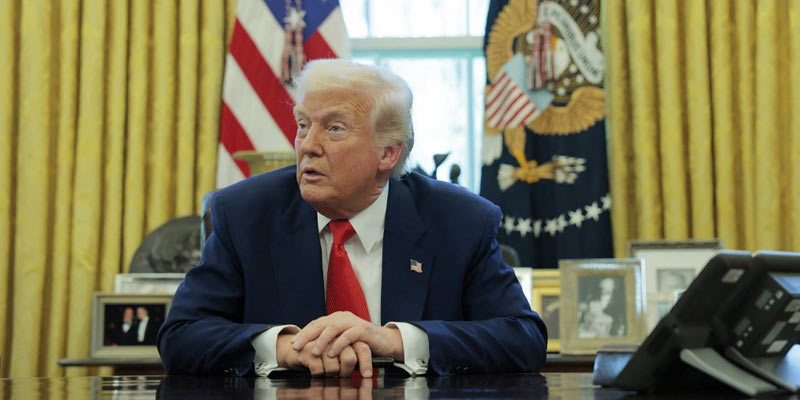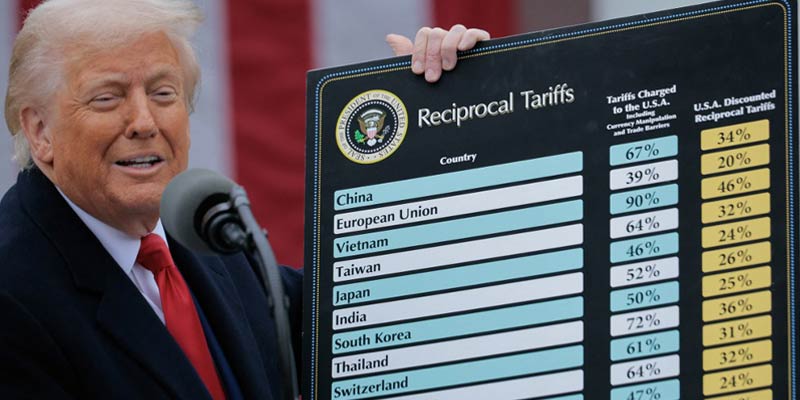- World
- Apr 10
Trump announces 90-day pause on reciprocal tariffs
• US President Donald Trump announced a 90-day pause on reciprocal tariffs, with the exception of China on April 9.
• Trump said he was raising tariffs on China to 125 per cent. The US President added that trade deals will be made with all countries.
• Markets have been on a rollercoaster ride since Trump’s announcement of sweeping global tariffs on April 2, what he called “Liberation Day”.
• Trump had imposed a 10 per cent baseline tariffs on all countries which came into effect on April 5, and higher rates on key trading partners like China and the European Union
• Trump believes his policy will revive America’s lost manufacturing base by forcing companies to relocate to the United States.
• Trump’s tariffs had sparked days-long selloff that erased trillions of dollars from global stocks and pressured US Treasury bonds and the dollar.
• Beijing had raised tariffs on US imports to 84 per cent in retaliation for Trump himself ramping up duties on Chinese goods to 104 per cent.
• The European Union also launched its own counterattack, announcing measures targeting some US products in retaliation for American duties on global steel and aluminum exports.
What is tariff?
• The word tariff has been catapulted from the business pages to the headlines over the last few months, as major economies impose or threaten them on other nations.
• But tariffs are not just a blunt weapon to be used in geopolitical brinkmanship. They can, if used effectively, help poorer countries develop their economies.
• A tariff or duty (the words are used interchangeably) is a tax levied by governments on imported products. Different tariffs are applied on different products by different countries.
• The tariff, along with the other assessments, is collected at the time of customs clearance in the foreign port.
• The UN defines tariffs as customs duties on merchandise imports, levied either on a percentage of value or on a specific basis.
• Historically, tariffs were a major source of revenue for many countries and were often the primary source of federal revenue through the late 19th century. Today, other taxes account for most government revenue in developed countries.
• Tariffs are now typically used selectively to protect certain domestic industries, advance foreign policy goals, or as negotiating leverage in trade negotiations.
• Tariffs are used widely, but they are imposed following rules that have been negotiated within the World Trade Organisation (WTO) or regional organisations.
• Reciprocal tariffs are imposed by countries to counter increases in duties or high tariffs by trading partners. It can be described as a tit-for-tat tax.
• Many important actors in global trade, such as the United States, the European Union and China, are imposing tariffs or measures that are not always in line with their commitments in the WTO.
• When Member States make unilateral decisions, without going through the WTO or UN System, it can create uncertainty, which may end up creating a slowdown in investment decisions in the private sector, in trade, economic growth and job creation.
• There have always been differences among countries, with certain sectors more affected by changes than others, and economic conditions can require certain kind of interventions.
• Developed countries often use tariffs as part of broader economic policies aimed at protecting specific industries or responding to international trade dynamics. In contrast, developing countries may use tariffs more broadly to protect nascent industries and support economic development.
• Experts say that tariffs themselves are not necessarily a problem. The issue is the uncertainty that results from big economic players ripping up the playbook of international trade rules.
• One way of helping an industry develop and grow is by protecting it, through tariffs, from foreign competition. The downside is that production of those goods for the domestic market is more expensive, and you may also deter competition.
• Another important point is governments need revenue. Tariffs are a tax, and a tax is income that a government can spend on social spending, health, education or infrastructure. But again, this means higher costs on imported goods for consumers.
Manorama Yearbook app is now available on Google Play Store and iOS App Store


